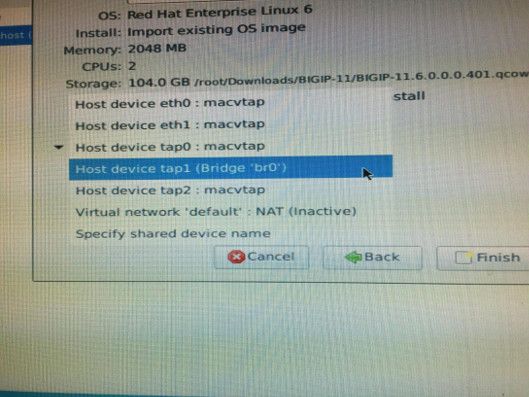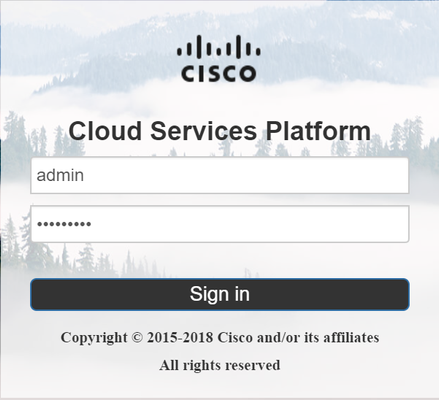kvm
6 TopicsBIGIP Next - SHARED-00001: Internal server error
In the process of setting up a BIGIP Next Lab on 20.2. After getting the CM and two Instances deployed and the two instances pulled into CM. I get this error when trying to look at details of either instance. Error: Unable to retrieve this BIG-IP Next instance's creation manifest: SHARED-00001: Internal server error So far I have not been able to figure what is causing this error. Gone as rebuilt everything with 20.1 and 20.0 versions and the error is still there, just worded differently between the versions. Instance status show Healthy, i am just unable to move on with creating vlans, ha and such because that error message is preventing edit of instance details Any ideas? I am still new to working with Next so stumbling through were to find logs and such compare to BIGIP Classic :)Solved295Views0likes3CommentsWhat am I doing wrong with this network configuration for KVM (F5 virtual edition)
Hello, I have been trying to setup an F5 lab using KVM on debian. I currently have the following network configuration (/etc/network/interfaces - see output pasted at end of post) although whenever I go to create the VM in KVM, only one tap is associated with the bridge (trying to use the taps for management, external, and internal interfaces on the F5 VM). (see screenshot at end of post) Would anyone have any suggestions for configuring networking properly for this setup? I'm open to anything at this point in time. Thanks for your help. source /etc/network/interfaces.d/* auto lo iface lo inet loopback allow-hotplug eth0 iface eth0 inet dhcp iface eth0 inet6 auto auto br0 iface br0 inet dhcp pre-up ip tuntap add dev tap0 mode tap user root pre-up ip tuntap add dev tap1 mode tap user root pre-up ip tuntap add dev tap2 mode tap user root pre-up ip link set tap0 up pre-up ip link set tap1 up pre-up ip link set tap2 up bridge_ports all tap0 tap1 tap2 bridge_stp off bridge_maxwait 0 bridge_fd 0 post-down ip link set tap0 down post-down ip link set tap1 down post-down ip link set tap2 down post-down ip tuntap del dev tap0 mode tap post-down ip tuntap del dev tap1 mode tap post-down ip tuntap del dev tap2 mode tap330Views0likes1CommentHow to onboard F5 BIG-IP VE in Cisco CSP 2100/5000 for NFV solutions deployment
Are you considering Network Functions Virtualization (NFV) solutions for your data center? Are you wondering how your current F5 BIG-IP solutions can be translated into NFV environment? What NFV platform can be used with F5 NFV solutions in your data center? Good News! F5 has certified its BIG-IP NFV solutions with Cisco Cloud Services Platform (CSP). Click here for a complete list of versions validated. Cisco CSP is an open x86 Linux Kernel-based virtual machine (KVM) software and hardware platform is ideal for colocation and data center network functions virtualization (NFV). F5 has a broad portfolio of VNFs available on BIG-IP which include Virtual Firewall (vFW), Virtual Application Delivery Controllers (vADC), Virtual Policy Manager (vPEM), Virtual DNS (vDNS) and other BIG-IP products. F5 VNF + Cisco CSP 2100: together provides a joint solution that allow network administrators to quickly and easily deploy F5 VNFs through a simple, built-in, native web user interface (WebUI), command-line interface (CLI), or REST API. BIG-IP VE Key Features in CSP 10G throughput with SR-IOV PCIE or SR-IOV passthrough Intel X710 NIC - Quad 10G port supported All BIG-IP modules can run in CSP 2100 Follow the steps below to onboard F5 BIG-IP VE in Cisco CSP with a Day0 file Day0 file contents and creation Sample user_data #cloud-config write_files: - path: /config/onboarding/waitForF5Ready.sh permissions: 0755 owner: root:root content: | #!/bin/bash # This script checks the prompt while the device is # booting up, waiting until it is ready to accept # the provisioning commands. echo `date` -- Waiting for F5 to be ready sleep 5 while [[ ! -e '/var/prompt/ps1' ]]; do echo -n '.' sleep 5 done sleep 5 STATUS=`cat /var/prompt/ps1` while [[ ${STATUS}x != 'NO LICENSE'x ]]; do echo -n '.' sleep 5 STATUS=`cat /var/prompt/ps1` done echo -n ' ' while [[ ! -e '/var/prompt/cmiSyncStatus' ]]; do echo -n '.' sleep 5 done STATUS=`cat /var/prompt/cmiSyncStatus` while [[ ${STATUS}x != 'Standalone'x ]]; do echo -n '.' sleep 5 STATUS=`cat /var/prompt/cmiSyncStatus` done echo echo `date` -- F5 is ready... - path: /config/onboarding/setupLogging.sh permissions: 0755 owner: root:root content: | #!/bin/bash # This script creates a file to collect the output # of the provisioning commands for debugging. FILE=/var/log/onboard.log if [ ! -e $FILE ] then touch $FILE nohup $0 0<&- &>/dev/null & exit fi exec 1<&- exec 2<&- exec 1<>$FILE exec 2>&1 - path: /config/onboarding/onboard.sh permissions: 0755 owner: root:root content: | #!/bin/bash # This script sets up the logging, waits until the device # is ready to provision and then executes the commands # to set up networking, users and register with F5. . /config/onboarding/setupLogging.sh if [ -e /config/onboarding/waitForF5Ready.sh ] then echo "/config/onboarding/waitForF5Ready.sh exists" /config/onboarding/waitForF5Ready.sh else echo "/config/onboarding/waitForF5Ready.sh is missing" echo "Failsafe sleep for 5 minutes..." sleep 5m fi echo "Configure access" tmsh modify sys global-settings hostname <<hostname>> tmsh modify auth user admin shell bash password <<admin_password>> tmsh modify sys db systemauth.disablerootlogin value true tmsh save /sys config echo "Disable mgmt-dhcp..." tmsh modify sys global-settings mgmt-dhcp disabled echo "Set Management IP..." tmsh create /sys management-ip <<mgmt_ip/mask>> Example: 10.192.74.46/24 tmsh create /sys management-route default gateway <<gateway_ip>> echo "Save changes..." tmsh save /sys config partitions all echo "Set NTP..." tmsh modify sys ntp servers add { 0.pool.ntp.org 1.pool.ntp.org } tmsh modify sys ntp timezone America/Los_Angeles echo "Add DNS server..." tmsh modify sys dns name-servers add { <<ntp_ip>> } tmsh modify sys httpd ssl-port 8443 tmsh modify net self-allow defaults add { tcp:8443 } if [[ \ "8443\ " != \ "443\ " ]] then tmsh modify net self-allow defaults delete { tcp:443 } fi tmsh mv cm device bigip1 <<hostname>> tmsh save /sys config echo "Register F5..." tmsh install /sys license registration-key <<license_key>> tmsh show sys license date runcmd: [nohup sh -c '/config/onboarding/onboard.sh' &] Sample meta_data.json { "uuid": "1d9d6d3a-1d36-4db7-8d7c-63963d4d6f20", "hostname": "<<hostname>>" } Preparation: Assuming the content are in a directory named ‘example_files/iso_contents/openstack/2012-08-10’ Once the values above are entered into the user_data file, create the ISO file: genisoimage -volid config-2 -rock -joliet -input-charset utf-8 -output f5.iso example_files/iso_contents/ or (depending on you OS) mkisofs -R -V config-2 -o f5.iso example_files/iso_contents/ Process on CSP Download F5 BIG-IP VE (release 12.1.2 of later) qcow image from http://downloads.f5.com Log into Cisco CSP 2100 Go to "Configuration" -> "Repository" -> "+" Click on “Browse” and locate the F5 BIG-IP VE qcow image, then click "Upload" Go back to “Configuration” -> “Repository and follow the same upload process for the Day0 iso file. At this point you should be to view both the qcow and Day0 iso image in the repository tab To create a F5 BIG-IP virtual function, go to "Configuration" -> "Services" -> "+" A wizard will pop up After deployment F5 BIG-IP VE virtual function deployment in Cisco CSP 2100 is completed, you can monitor the BIG-IP VE boot up progress by clicking "Console Since the BIG-IP is being booted with a Day0 file, NTP/DNS configurations are already present on the BIG-IP. The BIG-IP will be licensed and ready to be configured. The MGMT IP, default username/password was specified in the Day0 file. The Day0 file can be enhanced to add more networking and other configuration parameters if needed by specifying the appropriate tmsh commands. Make sure the BIG-IP interface mapping to CSP 2100 VNIC is correct by verifying the MAC address assignment. Consult with CSP 2100 guide in obtaining CSP 2100 VF VNIC MAC address info. To check BIG-IP MAC address, go to "Network" -> "Interfaces" To check on the CSP, click on the service deployed, scroll to the bottom, expand the VNIC information tab Configure VLAN consistent with the CSP 2100 VLAN tag configuration, make sure VLANs are untagged at the BIG-IP level After BIG-IP VE connectivity is established in the network rest of the configurations, such as Self-IP, default gateway, virtual servers are consistent with any BIG-IP VE configuration. To learn more about the F5 and Cisco partnership and joint solutions, visit https://f5.com/solutions/technology-alliances/cisco For more information about Cisco CSP visit http://www.cisco.com/go/csp Click here for a complete list of BIG-IP and CSP versions validated.1.4KViews0likes3CommentsKVM home lab setup and configuration
Hey guys, Has anyone used KVM as means of creating a virtual home lab with separate vlans. I have tried time and time again to get separate vlans created using virtualbox and have followed the documentation found on dev central but its seems out dated as I could not create separate vlans using bridging. The following is my current lab setup and configuration possibilities I am seeking advice on. Host: Laptop running Ubuntu 16.04 (using 15.10 but will upgrading soon to the new LTS) Guests: Some distro running lamp, debain or centos Network: I was able to configure the management interface just fine 192.168.1.254 VLANS: I am not too experienced with kvm so I am not sure the best way to configure seperate vlans. But I have attempted this but again I could not created the vlans for so that my Guests could send traffic on. Ideas that I have been tossing around: -use cumlus vm switch to emulate a switch and assign vlan ids and vlans on it -using avaya os to emulate switching and routing... not sure if avaya can also do L3 switching or not? Any suggestions and or experiences will be helpful Thanks427Views0likes1Commentkvm and arch linux
Hey guys, Question if I am running arch linux as a host machine using arch linux with kvm will LTM be supported if I were to use it as a guest?, or is kvm only supported with a selected handful of distros that run as a host such as debian, ubuntu, fedora, centos etc Thanks200Views0likes1Comment


